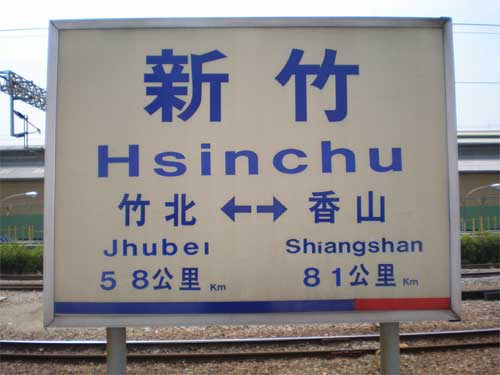Most of the pages in this are devoted to a list of the syllables of Taiwanese. Without counting tones Taiwanese has nearly twice as many unique syllables as Mandarin (797 vs. about 410, respectively).
Here’s the list of Taiwanese syllables, as given in Taiwan’s current official romanization system for Hoklo:
a, ah, ai, ainn, ak, am, an, ang, ann, ap, at, au, ba, bah, bai, bak, ban, bang, bat, bau, be, beh, bi, bian, biat, biau, bih, bik, bin, bing, bio, bit, biu, bo, bok, bong, boo, bu, bua, buah, buan, buat, bue, bueh, bui, bun, but, e, eh, enn, ga, gai, gak, gam, gan, gang, gau, ge, gi, gia, giah, giam, gian, giang, giap, giat, giau, gik, gim, gin, ging, gio, gioh, giok, giong, giu, go, gok, gong, goo, gu, gua, guan, guat, gue, gueh, gui, ha, hah, hai, hainn, hak, ham, han, hang, hann, hannh, hap, hat, hau, he, heh, henn, hennh, hi, hia, hiah, hiam, hian, hiang, hiann, hiannh, hiap, hiat, hiau, hiauh, hik, him, hin, hing, hinn, hio, hioh, hiok, hiong, hip, hit, hiu, hiunn, hiunnh, hm, hmh, hng, hngh, ho, hoh, hok, hong, honn, honnh, hoo, hu, hua, huah, huai, huainn, huan, huann, huat, hue, hueh, hui, hun, hut, i, ia, iah, iam, ian, iang, iann, iap, iat, iau, iaunn, ik, im, in, ing, inn, io, ioh, iok, iong, ip, it, iu, iunn, ji, jia, jiam, jian, jiang, jiap, jiat, jiau, jim, jin, jio, jiok, jiong, jip, jit, jiu, ju, juah, jue, jun, ka, kah, kai, kainn, kak, kam, kan, kang, kann, kap, kat, kau, kauh, ke, keh, kenn, kha, khah, khai, khainn, khak, kham, khan, khang, khann, khap, khat, khau, khe, kheh, khenn, khennh, khi, khia, khiah, khiak, khiam, khian, khiang, khiap, khiat, khiau, khiauh, khih, khik, khim, khin, khing, khinn, khio, khioh, khiok, khiong, khip, khit, khiu, khiunn, khng, kho, khok, khong, khoo, khu, khua, khuah, khuai, khuan, khuann, khuat, khue, khueh, khuh, khui, khun, khut, ki, kia, kiah, kiam, kian, kiann, kiap, kiat, kiau, kik, kim, kin, king, kinn, kio, kioh, kiok, kiong, kip, kit, kiu, kiunn, kng, ko, koh, kok, kong, konn, koo, ku, kua, kuah, kuai, kuainn, kuan, kuann, kuat, kue, kueh, kui, kun, kut, la, lah, lai, lak, lam, lan, lang, lap, lat, lau, lauh, le, leh, li, liah, liam, lian, liang, liap, liat, liau, lih, lik, lim, lin, ling, lio, lioh, liok, liong, lip, liu, lo, loh, lok, long, loo, lu, lua, luah, luan, luat, lue, lui, lun, lut, m, ma, mai, mau, mauh, me, meh, mi, mia, miau, mih, mng, moo, mooh, mua, mui, na, nah, nai, nau, nauh, ne, neh, ng, nga, ngai, ngau, nge, ngeh, ngia, ngiau, ngiauh, ngoo, ni, nia, niau, nih, niu, nng, noo, nua, o, oh, ok, om, ong, onn, oo, pa, pah, pai, pak, pan, pang, pat, pau, pe, peh, penn, pha, phah, phai, phainn, phak, phan, phang, phann, phau, phauh, phe, phenn, phi, phiah, phiak, phian, phiang, phiann, phiat, phiau, phih, phik, phin, phing, phinn, phio, phit, phngh, pho, phoh, phok, phong, phoo, phu, phua, phuah, phuan, phuann, phuat, phue, phueh, phuh, phui, phun, phut, pi, piah, piak, pian, piang, piann, piat, piau, pih, pik, pin, ping, pinn, pio, pit, piu, png, po, poh, pok, pong, poo, pu, pua, puah, puan, puann, puat, pue, pueh, puh, pui, pun, put, sa, sah, sai, sak, sam, san, sang, sann, sannh, sap, sat, sau, se, seh, senn, si, sia, siah, siak, siam, sian, siang, siann, siap, siat, siau, sih, sik, sim, sin, sing, sinn, sio, sioh, siok, siong, sip, sit, siu, siunn, sng, sngh, so, soh, sok, som, song, soo, su, sua, suah, suai, suainn, suan, suann, suat, sue, sueh, suh, sui, sun, sut, ta, tah, tai, tainn, tak, tam, tan, tang, tann, tap, tat, tau, tauh, te, teh, tenn, tha, thah, thai, thak, tham, than, thang, thann, thap, that, thau, the, theh, thenn, thi, thiah, thiam, thian, thiann, thiap, thiat, thiau, thih, thik, thim, thin, thing, thinn, thio, thiok, thiong, thiu, thng, tho, thoh, thok, thong, thoo, thu, thua, thuah, thuan, thuann, thuat, thuh, thui, thun, thut, ti, tia, tiah, tiak, tiam, tian, tiann, tiap, tiat, tiau, tih, tik, tim, tin, ting, tinn, tinnh, tio, tioh, tiok, tiong, tit, tiu, tiuh, tiunn, tng, to, toh, tok, tom, tong, too, tsa, tsah, tsai, tsainn, tsak, tsam, tsan, tsang, tsann, tsap, tsat, tsau, tse, tseh, tsenn, tsha, tshah, tshai, tshak, tsham, tshan, tshang, tshann, tshap, tshat, tshau, tshauh, tshe, tsheh, tshenn, tshi, tshia, tshiah, tshiak, tshiam, tshian, tshiang, tshiann, tshiap, tshiat, tshiau, tshih, tshik, tshim, tshin, tshing, tshinn, tshio, tshioh, tshiok, tshiong, tship, tshit, tshiu, tshiunn, tshng, tshngh, tsho, tshoh, tshok, tshong, tshoo, tshu, tshua, tshuah, tshuan, tshuang, tshuann, tshue, tshuh, tshui, tshun, tshut, tsi, tsia, tsiah, tsiam, tsian, tsiang, tsiann, tsiap, tsiat, tsiau, tsih, tsik, tsim, tsin, tsing, tsinn, tsio, tsioh, tsiok, tsiong, tsip, tsit, tsiu, tsiunn, tsng, tso, tsoh, tsok, tsong, tsoo, tsu, tsua, tsuah, tsuainn, tsuan, tsuann, tsuat, tsue, tsuh, tsui, tsun, tsut, tu, tua, tuan, tuann, tuat, tue, tuh, tui, tun, tut, u, ua, uah, uai, uainn, uan, uang, uann, uat, ue, ueh, uh, ui, un, ut

